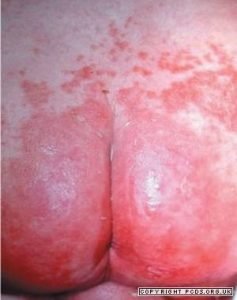The Avon Longitudinal Study of Parents and Children (ALSPAC) study collected information about nappy rash using self-completed questionnaires answered by parents at the end of the first four weeks of their baby’s life. The study found that 25% of the babies had experienced napkin dermatitis.
NICE has a comprehensive clinical knowledge summary on nappy rash here. Salient points:
- Skin swabs are not recommended for the management of nappy rash as the results are difficult to interpret.
- Both Candida and bacteria (such as Staphylococcus aureus) colonize healthy skin and a skin swab may be positive when infection is not present.
- A swab should only be taken when a secondary bacterial infection is suspected, to guide choice of antibiotic
This picture and more available on the excellent Primary Care Dermatology Society website. Compare this candidiasis picture with ammoniacal dermatitis and napkin eczema.
- Consider using nappies with the greatest absorbency (for example, disposable gel matrix nappies)
- Leave nappies off for as long as is practically possible. Clean and change the child as soon as possible after wetting or soiling. Use water, or fragrance-free and alcohol-free baby wipes.
- Dry gently after cleaning — avoid vigorous rubbing.
- Bath the child daily — but avoid excessive bathing (such as more than twice a day) which may dry the skin.
- Do not use soap, bubble bath, or lotions. Advise about skin care.
- Prescribe a barrier preparation to apply thinly at each nappy change, to protect the skin. Zinc and Castor Oil ointment BP or Metanium® ointment are recommended. Alternatively, white soft paraffin BP ointment or dexpanthenol 5% ointment (Bepanthen®) could be used.
- For children over 1 month of age, consider prescribing topical hydrocortisone 0.5% or 1% cream once a day for 7 days max.
